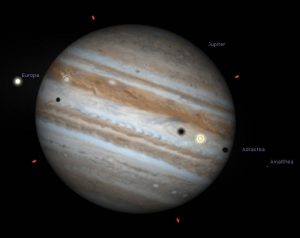With the closing months of 2018 almost upon us, we take a look at what the spring and summer skies have to offer.
As we watch Mars recede in size and brightness, we see it reveal the last of its surface detail before becoming too small for practical observation, with the dust storm that enveloped the planet at Opposition receding in a race between size and clarity.
 Venus on the other hand will grow to its largest size & most slender phase before it is lost in the suns glare in Mid October, before returning to the morning sky in November. We will also lose Jupiter to its conjunction with the Sun by the end of October.
Venus on the other hand will grow to its largest size & most slender phase before it is lost in the suns glare in Mid October, before returning to the morning sky in November. We will also lose Jupiter to its conjunction with the Sun by the end of October.
Saturn remains a great target for observing though October before diving towards the Sun by the end of November.
Fleet footed Mercury reaches its greatest height in the evening sky on the 7th of November, as its last apparition in the evening sky of 2018. With Mercury’s return to the evening sky, we have all seven planets visible mid month in October.
Uranus reaches opposition and it’s brightest in the evening sky on the 24th of October at magnitude 5.7, just above naked eye visibility. Finally Neptune, which came to Opposition in September is at its highest point in the evening sky around 9:30 this in mid October.
On any given night the diligent observer away from city lights will see around 6 “sporadic” Meteors per hour under dark skies. This number is however increased by many known Meteor showers, usually the debris left behind by the passage of a comet 100’s of years past. We have one of our best meteor showers of the year in December with the arrival of the Geminids. With up to 120 Meteors per hour, this Shower is unusual with the source being the Asteroid 3200 Phaethon. The peak of this display is on the night of Dec 14th & morning of the 15th. While not as numerous, the Taurid Meteor Shower peaking on the 10th of October is noted for the high proportion of bright fireball Meteors which are hard to miss !
As we turn our attention to deep space in the mid evening, we look first to the southern sky where we we find the familiar southern cross is now absent from our evening skies. However it is replaced by a delight that can only be be easily seen from the Southern Hemisphere. They are the so called Magellanic Clouds, which are in fact our nearest Galaxies, bound in gravitational orbit around our own Milky Way galaxy. Even a pair of binoculars will reveal the many large Nebula associated with our nearest galactic Neighbours.
Swing across to the northern sky we see the obvious bright stars of Vega, Altair & Deneb making up The Summer Triangle and a host of interesting deep sky targets. As we get closer to December the constellations of Pegasus & Andromeda dominate the northern Sky. In Andromeda we find the mighty Andromeda Galaxy as the other Galaxy Visible to the naked eye and a delight through a pair of large aperture binoculars. While along the path of the ecliptic the constellations of Capricorn, Pisces & Taurus dominate , with Orion the hunter hot on their heals as we move into December.
There is so much to see even with a good quality pair of Binoculars or a telescope as you delve deeper into the hidden mysteries of the night sky. At night sky secrets we can help you with all your binocular & Telescope needs, whatever your budget or experience level.


